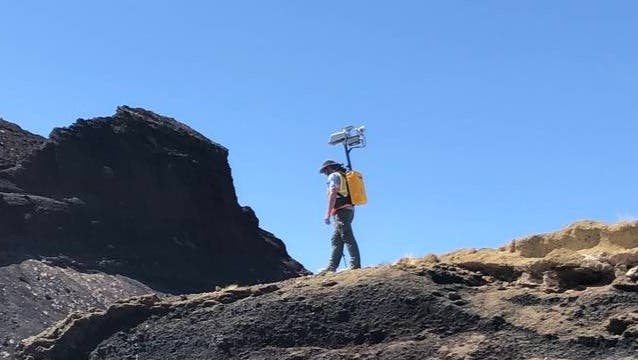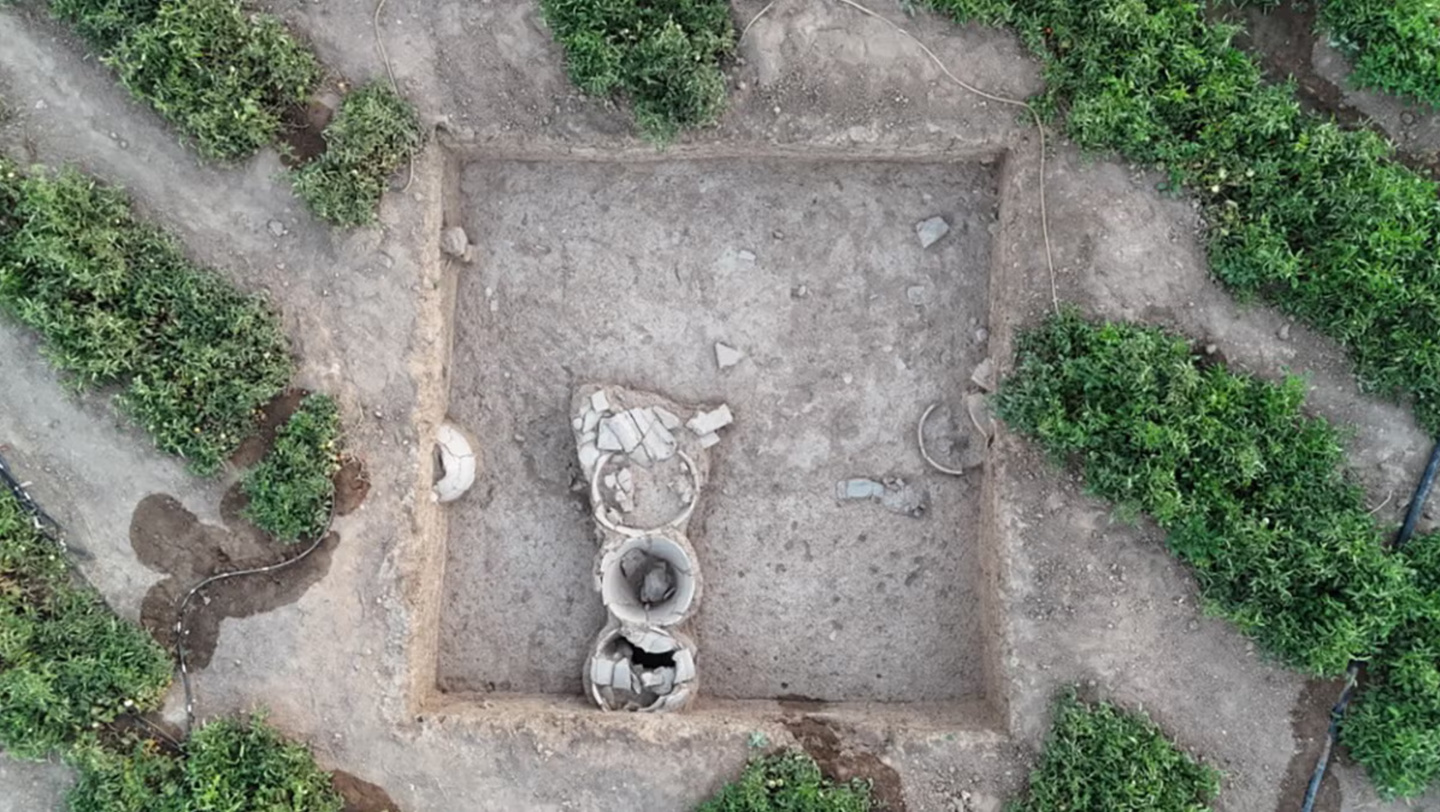NASA develops ‘Lunar Backpack’ to aid lunar exploration
The sensor is a surveying tool for both navigation and science mapping, able to create ultra-high-resolution 3D maps at centimeter precision

[May 3, 2022: Molly Porter, NASA / Marshall Space Flight Center]
Michael Zanetti, a NASA planetary scientist at NASA’s Marshall Space Flight Center in Huntsville, Alabama, hikes the Cinder cone in Potrillo volcanic field in New Mexico in late 2021, testing the backpack-sized prototype for NASA’s Kinematic Navigational and Cartography Knapsack (KNaCK), a mobile lidar scanner now in development to support lunar exploration and science missions. (CREDIT: NASA / Michael Zanetti)
Think of it as a superpowered version of laser range finders used by surveyors or the highly sensitive proximity alarms that help smart cars avoid collisions, said planetary scientist Dr. Michael Zanetti, who leads the KNaCK project at NASA’s Marshall Space Flight Center in Huntsville, Alabama.
“Basically, the sensor is a surveying tool for both navigation and science mapping, able to create ultra-high-resolution 3D maps at centimeter-level precision and give them a rich scientific context,” Zanetti said. “It also will help ensure the safety of astronauts and rover vehicles in a GPS-denied environment such as the Moon, identifying actual distances to far-off landmarks and showing explorers in real time how far they’ve come and how far is left to go to reach their destination.”
That’s a key challenge as Artemis-era explorers prepare to undertake the first modern missions to the Moon, and the first ever to its South Pole. The Sun never rises more than 3 degrees above the lunar horizon there, leaving much of the terrain in deep shadow. That makes distances to various points of interest difficult to eyeball.
Initiated in 2020 with funding by NASA’s Early Career Initiative, the KNaCK project has partnered with Torch Technologies Inc. of Huntsville to develop the backpack prototype and associated navigation algorithms that permit accurate mapping without GPS. The project’s commercial vendor, Aeva Inc. of Mountain View, California, is supplying FMCW-lidar sensors and support, working with NASA to enhance the backpack’s lidar sensing system for use on the Moon and other extraplanetary human excursions.
Related Stories
Using KNaCK during rover excursions and when traveling on foot, explorers could precisely map the topography of the landscape, including deep ravines, mountains, and caves. Lidar even works in pitch blackness, relieving astronauts of the need to haul cumbersome lighting rigs everywhere they go.
This video of a UAV drone landing in the dusty New Mexico desert demonstrates how the KNaCK technology – leveraging 4D FMCW-lidar data from NASA vendor Aeva Inc. of Mountain View, California – combines live, real-time high-definition video imaging, as seen at upper left panel; lidar ranging data, at upper right; and lidar Doppler velocity data. The latter tracks the speed and direction of dust particles kicked up by the descending drone, with red indicating particles moving away from the scanner and blue indicating those moving toward it. Such capabilities, now in development by researchers at NASA’s Marshall Space Flight Center in Huntsville, Alabama, could benefit future science missions on other worlds in addition to enabling real-time topographical mapping by explorers. (CREDIT: NASA/Michael Zanetti)
“As human beings, we tend to orient ourselves based on landmarks – a specific building, a grove of trees,” Zanetti said. “Those things don’t exist on the Moon. KNaCK will continuously enable explorers traversing the surface to determine their movement, direction, and orientation to distant peaks or to their base of operations. They can even mark specific sites where they found some unique mineral or rock formation, so others can easily return for further study.”
That’s vital for astronauts on a clock, their excursions limited by the oxygen supply in their suits. KNaCK’s ultra-high-resolution precision – an order of magnitude greater than conventional lunar topography maps and elevation models – makes it a vital resource for conducting science and mission operations 238,900 miles away from mission control, Zanetti said.
The hardware will get another major field test in late April at NASA’s Solar System Exploration Research Virtual Institute (SSERVI) in Kilbourne Hole, New Mexico. The team previously put the KNaCK system through its paces at that ancient volcanic crater – estimated to be 25,000-80,000 years old – in November 2021. They also used it recently to conduct a 3D reconstruction of the 6-mile-long sea barrier dunes at NASA’s Kennedy Space Center in Florida, which protect its primary rocket launch pads. Kennedy and Marshall engineers will continue to use KNaCK to assess the impact of storms on dune erosion, ensuring the safety of future flight missions as they further refine the system.
Next, the KNaCK team will work to miniaturize the hardware – the backpack prototype weighs about 40 pounds – and harden the sensitive electronics against the punishing effects of microgravity and solar radiation.
"Taking advantage of the latest advancements in lidar technology from Aeva, our next-generation space-hardened unit with support from Torch Technologies will be about the size of a soda can and could enable lunar surface operations like never before," Zanetti said. He envisions mounting it on a rover or on the side of an astronaut’s helmet – which should leave plenty of room in future lunar mountaineers’ all-purpose backpacks.
For more science and technology news stories check out our New Innovations section at The Brighter Side of News.
Note: Materials provided above by NASA / Marshall Space Flight Center. Content may be edited for style and length.
Like these kind of feel good stories? Get the Brighter Side of News' newsletter.
Tags: #New_Innovations, #NASA, #Space, #Moon, #Lasers, #Mapping, #Distances, #Navigation, #Technology, #Research, #The_Brighter_Side_of_News
Joseph Shavit
Head Science News Writer | Communicating Innovation & Discovery
Based in Los Angeles, Joseph Shavit is an accomplished science journalist, head science news writer and co-founder at The Brighter Side of News, where he translates cutting-edge discoveries into compelling stories for a broad audience. With a strong background spanning science, business, product management, media leadership, and entrepreneurship, Joseph brings a unique perspective to science communication. His expertise allows him to uncover the intersection of technological advancements and market potential, shedding light on how groundbreaking research evolves into transformative products and industries.



